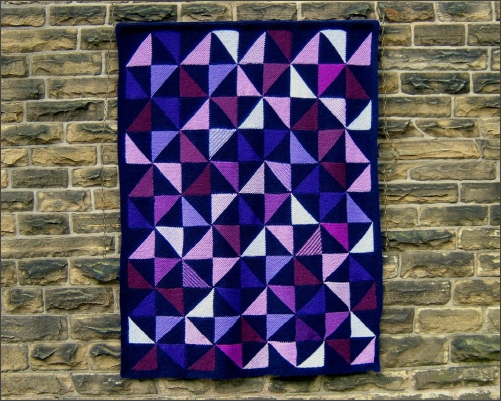




At the end of 1998 we realised that something was missing. We had no afghan of our
own using the half and half squares that we had used so often in schools. We had
sweaters, cardigans, hats and other small items but nothing on the scale we were
now accustomed to working at. This situation had to be rectified. I knit ninety-
We called this piece Tilting at Windmills. It is definitely the one we have used most often and for many years was the most requested of our pattern booklets. It doesn’t matter where we take it or what the age or understanding of a group might be, we know now that we can ask one simple question and not need to say anything else again for a long time.
The question we pose is ‘Is this a pattern?’
Some people look at us as though it is a totally pointless question but, at the same time there will always be those who land firmly on one side of the fence and can’t understand why there should be anyone on the other side. Arguments follow. The first time we saw this happening it came as a bit of a shock. It eventually became apparent that those who declared that it was a pattern were not taking notice of the colours at all. The shapes made a pattern and that was all that mattered to them. On the other side were those who insisted that if the colours were wrong it couldn’t possibly be a pattern. It certainly justified our arguments for not using colours in Woolly Thoughts though we had not been prepared for this extreme reaction which happens every time a group of people look at the hanging.
This had implications for our normal classroom teaching. Almost every teacher provides pupils with coloured shapes for particular tasks but we rarely make it clear whether the colours are strictly relevant to the task. Perhaps those pupils who struggle are not seeing the task as we intended it to be.
Having established that not everyone is seeing the pieces in the same way, we move on to asking the audience to describe what shapes they see. The answers are many and varied. One of the most obvious shapes is the windmill but even that causes disagreements. Some see windmills turning clockwise, others see them going anticlockwise. Both types of windmill are there. It is just a matter of seeing a different point as being the centre. Discussions can go on for hours, or days. If the hanging is left in a room for a long period of time pupils are not consciously looking for new shapes. There is often a surprised exclamation as something else is spotted. It appears to change every day. This was almost the same design Brown Sheep had used so long before. We had gone in a circle and returned to where the afghans started.
